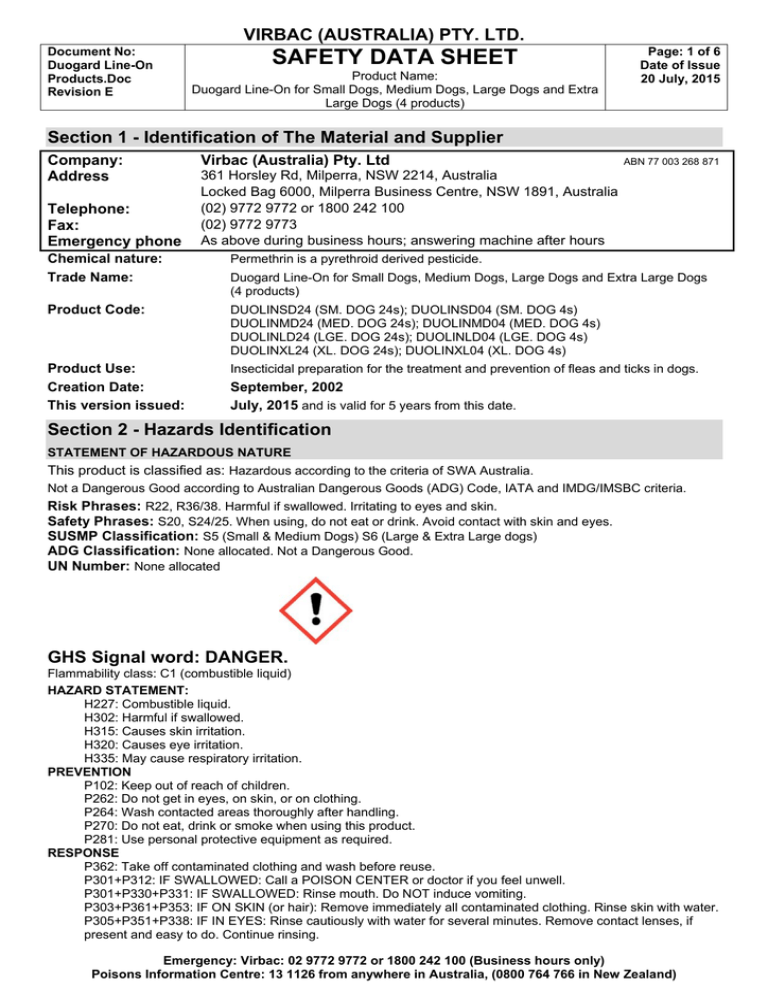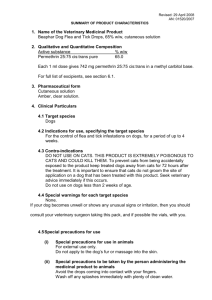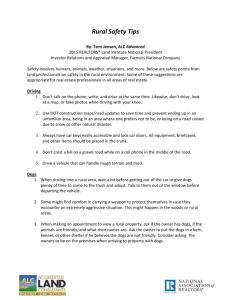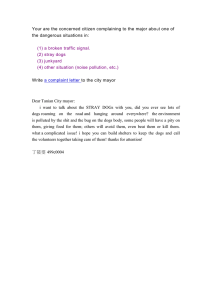SDS - Virbac Animal Health
advertisement

VIRBAC (AUSTRALIA) PTY. LTD. Document No: Duogard Line-On Products.Doc Revision E SAFETY DATA SHEET Product Name: Duogard Line-On for Small Dogs, Medium Dogs, Large Dogs and Extra Large Dogs (4 products) Page: 1 of 6 Date of Issue 20 July, 2015 Section 1 - Identification of The Material and Supplier Company: Address Telephone: Fax: Emergency phone Virbac (Australia) Pty. Ltd 361 Horsley Rd, Milperra, NSW 2214, Australia Locked Bag 6000, Milperra Business Centre, NSW 1891, Australia (02) 9772 9772 or 1800 242 100 (02) 9772 9773 As above during business hours; answering machine after hours Chemical nature: Trade Name: Permethrin is a pyrethroid derived pesticide. Product Code: DUOLINSD24 (SM. DOG 24s); DUOLINSD04 (SM. DOG 4s) DUOLINMD24 (MED. DOG 24s); DUOLINMD04 (MED. DOG 4s) DUOLINLD24 (LGE. DOG 24s); DUOLINLD04 (LGE. DOG 4s) DUOLINXL24 (XL. DOG 24s); DUOLINXL04 (XL. DOG 4s) Product Use: Creation Date: This version issued: ABN 77 003 268 871 Duogard Line-On for Small Dogs, Medium Dogs, Large Dogs and Extra Large Dogs (4 products) Insecticidal preparation for the treatment and prevention of fleas and ticks in dogs. September, 2002 July, 2015 and is valid for 5 years from this date. Section 2 - Hazards Identification STATEMENT OF HAZARDOUS NATURE This product is classified as: Hazardous according to the criteria of SWA Australia. Not a Dangerous Good according to Australian Dangerous Goods (ADG) Code, IATA and IMDG/IMSBC criteria. Risk Phrases: R22, R36/38. Harmful if swallowed. Irritating to eyes and skin. Safety Phrases: S20, S24/25. When using, do not eat or drink. Avoid contact with skin and eyes. SUSMP Classification: S5 (Small & Medium Dogs) S6 (Large & Extra Large dogs) ADG Classification: None allocated. Not a Dangerous Good. UN Number: None allocated GHS Signal word: DANGER. Flammability class: C1 (combustible liquid) HAZARD STATEMENT: H227: Combustible liquid. H302: Harmful if swallowed. H315: Causes skin irritation. H320: Causes eye irritation. H335: May cause respiratory irritation. PREVENTION P102: Keep out of reach of children. P262: Do not get in eyes, on skin, or on clothing. P264: Wash contacted areas thoroughly after handling. P270: Do not eat, drink or smoke when using this product. P281: Use personal protective equipment as required. RESPONSE P362: Take off contaminated clothing and wash before reuse. P301+P312: IF SWALLOWED: Call a POISON CENTER or doctor if you feel unwell. P301+P330+P331: IF SWALLOWED: Rinse mouth. Do NOT induce vomiting. P303+P361+P353: IF ON SKIN (or hair): Remove immediately all contaminated clothing. Rinse skin with water. P305+P351+P338: IF IN EYES: Rinse cautiously with water for several minutes. Remove contact lenses, if present and easy to do. Continue rinsing. Emergency: Virbac: 02 9772 9772 or 1800 242 100 (Business hours only) Poisons Information Centre: 13 1126 from anywhere in Australia, (0800 764 766 in New Zealand) VIRBAC (AUSTRALIA) PTY. LTD. Document No: Duogard Line-On Products.Doc Revision E SAFETY DATA SHEET Product Name: Duogard Line-On for Small Dogs, Medium Dogs, Large Dogs and Extra Large Dogs (4 products) Page: 2 of 6 Date of Issue 20 July, 2015 P309+P311 If exposed or if you feel unwell: Call a POISON CENTER or doctor/physician. P333+P313: If skin irritation or rash occurs: Get medical advice. P337+P313: If eye irritation persists: Get medical advice. P370+P378: In case of fire, use carbon dioxide, dry chemical, foam, water fog. STORAGE P410: Protect from sunlight. P402+P404: Store in a dry place. Store in a closed container. P403+P235: Store in a well-ventilated place. Keep cool. DISPOSAL P501: Dispose of contents and containers as specified on the registered label. Emergency Overview Physical Description & colour: Clear liquid, presented in 2, 4 and 8mL flexible pipettes. Odour: No date. Major Health Hazards: Permethrin is harmful to non-harmful via the oral route, with a reported LD50 for technical Permethrin in rats of 430 to 4000 mg/kg. Via the dermal route, it is not harmful, with a reported dermal LD50 in rats of over 4000 mg/kg, and in rabbits of greater 2000 mg/kg. No major health hazards are known. Potential Health Effects See section 11 for Chronic exposure studies. Inhalation Short term exposure: Available data indicates that this product is not harmful. However product may be mildly irritating, although unlikely to cause anything more than mild transient discomfort. Skin Contact: Short term exposure: Available data indicates that this product is not harmful. It should present no hazards in normal use. However product is a skin irritant. Symptoms may include itchiness and reddening of contacted skin. Other symptoms may also become evident, but all should disappear once exposure has ceased. Eye Contact: Short term exposure: Available data shows that this product is not harmful. However product is an eye irritant. Symptoms may include stinging and reddening of eyes and watering which may become copious. Other symptoms may also become evident. If exposure is brief, symptoms should disappear once exposure has ceased. However, lengthy exposure or delayed treatment may cause permanent damage. Ingestion: Short term exposure: Available data shows that this product is harmful, but symptoms are not available. However, this product may be irritating to mucous membranes but is unlikely to cause anything more than transient discomfort. Carcinogen Status: SWA: No significant ingredient is classified as carcinogenic by SWA. NTP: No significant ingredient is classified as carcinogenic by NTP. IARC: Permethrin is Class 3 - unclassifiable as to carcinogenicity to humans. Section 3 – Composition/Information on Ingredients Ingredients CAS No Conc,% TWA (mg/m3) STEL (mg/m3) Permethrin 52645-53-1 34.1 not set not set Pyriproxyfen 95737-68-1 0.3 not set not set Glycol ether (solvent) secret to 100 not set not set This is a commercial product whose exact ratio of components may vary slightly. Minor quantities of other non hazardous ingredients are also possible. The TWA exposure value is the average airborne concentration of a particular substance when calculated over a normal 8 hour working day for a 5 day working week. The STEL (Short Term Exposure Limit) is an exposure value that should not be exceeded for more than 15 minutes and should not be repeated for more than 4 times per day. There should be at least 60 minutes between successive exposures at the STEL. The term "peak "is used when the TWA limit, because of the rapid action of the substance, should never be exceeded, even briefly. Section 4 - First Aid Measures General Information: Emergency: Virbac: 02 9772 9772 or 1800 242 100 (Business hours only) Poisons Information Centre: 13 1126 from anywhere in Australia, (0800 764 766 in New Zealand) VIRBAC (AUSTRALIA) PTY. LTD. Document No: Duogard Line-On Products.Doc Revision E SAFETY DATA SHEET Product Name: Duogard Line-On for Small Dogs, Medium Dogs, Large Dogs and Extra Large Dogs (4 products) Page: 3 of 6 Date of Issue 20 July, 2015 You should call The Poisons Information Centre if you feel that you may have been poisoned, burned or irritated by this product. The number is 13 1126 from anywhere in Australia and is available at all times. Have this SDS with you when you call. Inhalation: No first aid measures normally required. However, if inhalation has occurred, and irritation has developed, remove to fresh air and observe until recovered. If irritation becomes painful or persists more than about 30 minutes, seek medical advice. Skin Contact: Quickly and gently, blot or brush away excess chemical. Wash gently and thoroughly with water (use non-abrasive soap if necessary) for 20 minutes or until chemical is removed. Under running water, remove contaminated clothing, shoes and leather goods (e.g. watchbands and belts). If irritation persists, repeat flushing and obtain medical advice. Completely decontaminate clothing, shoes and leather goods before reuse or discard. Eye Contact: Quickly and gently blot or brush away product. Immediately flush the contaminated eye(s) with lukewarm, gently flowing water until the product is removed or until a few minutes after irritation has ceased, while holding the eyelid(s) open. Take care not to rinse contaminated water into the unaffected eye or onto the face. Ingestion: If swallowed, do NOT induce vomiting. Wash mouth with water and contact a Poisons Information Centre, or call a doctor. Section 5 – Fire Fighting Measures Fire and Explosion Hazards: There is a slight risk of an explosion from this product if commercial quantities are involved in a fire. Violent steam generation or eruption may occur upon application of direct water stream on hot liquids. Vapours from this product are heavier than air and may accumulate in sumps, pits and other low-lying spaces, forming potentially explosive mixtures. They may also flash back considerable distances. Fire decomposition products from this product may be toxic if inhaled. Take appropriate protective measures. Extinguishing Media: Preferred extinguishing media are carbon dioxide, dry chemical, foam, water fog. Fire Fighting: If a significant quantity of this product is involved in a fire, call the fire brigade. Flash point: No data Upper Flammability Limit: 22.7% Lower Flammability Limit: 1.4% (based on figures for solvent) Autoignition temperature: No data. Flammability Class: C1 Section 6 – Accidental Release Measures Accidental release: In the event of a major spill, prevent spillage from entering drains or water courses. Wear full protective clothing including face mask, face shield and gauntlets. All skin areas should be covered. See above under Personal Protection regarding Australian Standards relating to personal protective equipment. Suitable materials for protective clothing include rubber, PVC. Stop leak if safe to do so, and contain spill. Absorb onto sand, vermiculite or other suitable absorbent material. If spill is too large or if absorbent material is not available, try to create a dike to stop material spreading or going into drains or waterways. Sweep up and shovel or collect recoverable product into labelled containers for recycling or salvage, and dispose of promptly. Recycle containers wherever possible after careful cleaning. After spills, wash area preventing runoff from entering drains. If a significant quantity of material enters drains, advise emergency services. This material may be suitable for approved landfill. Ensure legality of disposal by consulting regulations prior to disposal. Thoroughly launder protective clothing before storage or re-use. Advise laundry of nature of contamination when sending contaminated clothing to laundry. Section 7 – Handling and Storage Handling: Keep exposure to this product to a minimum, and minimise the quantities kept in work areas. Check Section 8 of this SDS for details of personal protective measures, and make sure that those measures are followed. The measures detailed below under "Storage" should be followed during handling in order to minimise risks to persons using the product in the workplace. Also, avoid contact or contamination of product with incompatible materials listed in Section 10. Storage: This product is a Scheduled Poison. Observe all relevant regulations regarding sale, transport and storage of this class of poison. Make sure that containers of this product are kept tightly closed. Make sure that the product does not come into contact with substances listed under "Materials to avoid" in Section 10. Store below 30°C. Some liquid preparations settle or separate on standing and may require stirring before use. Check packaging - there may be further storage instructions on the label. Section 8 Exposure Controls and Personal Protection The following Australian Standards will provide general advice regarding safety clothing and equipment: Emergency: Virbac: 02 9772 9772 or 1800 242 100 (Business hours only) Poisons Information Centre: 13 1126 from anywhere in Australia, (0800 764 766 in New Zealand) VIRBAC (AUSTRALIA) PTY. LTD. Document No: Duogard Line-On Products.Doc Revision E SAFETY DATA SHEET Product Name: Duogard Line-On for Small Dogs, Medium Dogs, Large Dogs and Extra Large Dogs (4 products) Page: 4 of 6 Date of Issue 20 July, 2015 Respiratory equipment: AS/NZS 1715, Protective Gloves: AS 2161, Occupational Protective Clothing: AS/NZS 4501 set 2008, Industrial Eye Protection: AS1336 and AS/NZS 1337, Occupational Protective Footwear: AS/NZS2210. SWA Exposure Limits TWA (mg/m3) STEL (mg/m3) Exposure limits have not been established by SWA for any of the significant ingredients in this product. The ADI for Permethrin is set at 0.05mg/kg/day. The corresponding NOEL is set at 5mg/kg/day. The ADI for Pyriproxyfen is set at 0.07mg/kg/day. The corresponding NOEL is set at 7mg/kg/day. ADI means Acceptable Daily Intake and NOEL means No-observable-effect-level. Values taken from Australian ADI List, June 2013. Ventilation: No special ventilation requirements are normally necessary for this product. However make sure that the work environment remains clean and that dusts are minimised. Eye Protection: Protective glasses or goggles should be worn when this product is being used. Failure to protect your eyes may cause them harm. Emergency eye wash facilities are also recommended in an area close to where this product is being used. Skin Protection: Prevent skin contact by wearing impervious gloves, clothes and, preferably, apron. Make sure that all skin areas are covered. See below for suitable material types. Protective Material Types: We suggest that protective clothing be made from the following materials: rubber, PVC. Respirator: Usually, no respirator is necessary when using this product. However, if you have any doubts consult the Australian Standard mentioned above. Otherwise, not normally necessary. Eyebaths or eyewash stations and safety deluge showers should be provided near to where this product is being used. Section 9 - Physical and Chemical Properties: Physical Description & colour: Odour: Boiling Point: Freezing/Melting Point: Volatiles: Vapour Pressure: Vapour Density: Specific Gravity: Water Solubility: pH: Volatility: Clear liquid, presented in 2, 4 and 8mL flexible pipettes. No date. Not available. No specific data. Liquid at normal temperatures. No specific data. Expected to be low at 100°C. No data. No data. 1.07-1.11 Miscible. No data. No data. Section 10 – Stability and Reactivity Reactivity: This product is unlikely to react or decompose under normal storage conditions. However, if you have any doubts, contact the supplier for advice on shelf life properties. Conditions to Avoid: This product should be kept in a cool place, preferably below 30°C. Incompatibilities: strong acids, strong bases, strong oxidising agents. Fire Decomposition: Carbon dioxide, and if combustion is incomplete, carbon monoxide and smoke. Water. Carbon monoxide poisoning produces headache, weakness, nausea, dizziness, confusion, dimness of vision, disturbance of judgment, and unconsciousness followed by coma and death. Polymerisation: This product is unlikely to undergo polymerisation processes. Section 11 – Toxicological Information Toxicity: Acute toxicity: Permethrin is harmful to non-harmful via the oral route, with a reported LD50 for technical Permethrin in rats of 430 to 4000 mg/kg. Via the dermal route, it is not harmful, with a reported dermal LD50 in rats of over 4000 mg/kg, and in rabbits of greater 2000 mg/kg. Permethrin caused mild irritation of both the intact and abraded skin of rabbits. It also caused conjunctivitis when it was applied to the eyes. The 4-hour inhalation LC50 for rats was greater than 23.5 mg/L, indicating practically no inhalation toxicity. The toxicity of Permethrin is dependent on the ratio of the isomers present; the cis-isomer being more toxic. Chronic toxicity: No adverse effects were observed in dogs fed Permethrin at doses of 5 mg/kg/day for 90 days. Rats fed 150 mg/kg/day for 6 months showed a slight increase in liver weights. Very low levels of Permethrin in the diet of chickens (0.1 ppm for 3 to 6 weeks after hatching) have been reported to suppress immune system activity. Emergency: Virbac: 02 9772 9772 or 1800 242 100 (Business hours only) Poisons Information Centre: 13 1126 from anywhere in Australia, (0800 764 766 in New Zealand) VIRBAC (AUSTRALIA) PTY. LTD. Document No: Duogard Line-On Products.Doc Revision E SAFETY DATA SHEET Product Name: Duogard Line-On for Small Dogs, Medium Dogs, Large Dogs and Extra Large Dogs (4 products) Page: 5 of 6 Date of Issue 20 July, 2015 Reproductive effects: The fertility of female rats was affected when they received very high oral doses of 250 mg/kg/day of Permethrin during the 6th to 15th day of pregnancy. It is not likely that reproductive effects will be seen in humans under normal circumstances. Teratogenic effects: Permethrin is reported to show no teratogenic activity. Mutagenic effects: Permethrin is reported to show no mutagenic activity. Carcinogenic effects: The evidence regarding the carcinogenicity of Permethrin is inconclusive. Organ toxicity: Permethrin is suspected of causing liver enlargement of the liver and nerve damage. Effects on the immune system have been noted in animal studies. Fate in humans and animals: Permethrin is efficiently metabolized by mammalian livers. Breakdown products, or "metabolites," of Permethrin are quickly excreted and do not persist significantly in body tissues. When Permethrin is administered orally to rats, it is rapidly metabolized and almost completely eliminated from the body in a few days. Only 3 to 6% of the original dose was excreted unchanged in the faeces of experimental animals. Permethrin may persist in fatty tissues, with half-lives of 4 to 5 days in brain and body fat. Permethrin does not block, or inhibit, cholinesterase enzymes. Section 12 – Ecological Information Effects on birds: Permethrin is practically non-toxic to birds. The oral LD50 for a Permethrin formulation is greater than 9900 mg/kg in mallard ducks, greater than 13,500 mg/kg in pheasants, and greater than 15,500 mg/kg in Japanese quail. Effects on aquatic organisms: Aquatic ecosystems are particularly vulnerable to the impact of Permethrin. A fragile balance exists between the quality and quantity of insects and other invertebrates that serve as fish food. The 48-hour LC50 for rainbow trout is 0.0125 mg/L for 24 hours, and 0.0054 mg/L for 48 hours. The 48-hour LC50 in bluegill sunfish and salmon is 0.0018 mg/L. As a group, synthetic pyrethroids were toxic to all estuarine species tested. They had a 96-hour LC50 of less than or equal to 0.0078 mg/L for these species. The bioconcentration factor for Permethrin in bluefish is 715 times the concentrations in water and is 703 in catfish. This indicates that the compound has a low to moderate potential to accumulate in these organisms. Effects on other organisms: Permethrin is extremely toxic to bees. Severe losses may be expected if bees are present at treatment time, or within a day thereafter. Permethrin is also toxic to wildlife. It should not be applied, or allowed to drift, to crops or weeds in which active foraging takes place. Environmental Fate: Breakdown in soil and groundwater: Permethrin is of low to moderate persistence in the soil environment, with reported half-lives of 30 to 38 days. Permethrin is readily broken down, or degraded, in most soils except organic types. Soil microorganisms play a large role in the degradation of Permethrin in the soil. The addition of nutrients to soil may increase the degradation of Permethrin. It has been observed that the availability of sodium and phosphorous decreases when Permethrin is added to the soil. Permethrin is tightly bound by soils, especially by organic matter. Very little leaching of Permethrin has been reported. It is not very mobile in a wide range of soil types. Because Permethrin binds very strongly to soil particles and is nearly insoluble in water, it is not expected to leach or to contaminate groundwater. Breakdown in water: The results of one study near estuarine areas showed that Permethrin had a half-life of less than 2.5 days. When exposed to sunlight, the half-life was 4.6 days. Permethrin degrades rapidly in water, although it can persist in sediments. There was a gradual loss of toxicity after Permethrin aged for 48 hours in sunlight at 0.05 mg/L in water. Breakdown in vegetation: Permethrin is not phytotoxic, or poisonous, to most plants when it is used as directed. Some injury has occurred on certain ornamental plants. No incompatibility has been observed with Permethrin on cultivated plants. Treated apples, grapes, and cereal grains contain less than one mg/kg of Permethrin at harvest time. Section 13 – Disposal Considerations Disposal: Dispose of small quantities and empty containers by wrapping with paper and putting in garbage. For larger quantities, if recycling or reclaiming is not possible, use a commercial waste disposal service. Refer to product label for details. Section 14 – Transport Information UN Number: This product is not classified as a Dangerous Good by ADG, IATA or IMDG/IMSBC criteria. No special transport conditions are necessary unless required by other regulations. Section 15 – Regulatory Information AICS: All of the significant ingredients in this product are compliant with NICNAS regulations. Emergency: Virbac: 02 9772 9772 or 1800 242 100 (Business hours only) Poisons Information Centre: 13 1126 from anywhere in Australia, (0800 764 766 in New Zealand) VIRBAC (AUSTRALIA) PTY. LTD. Document No: Duogard Line-On Products.Doc Revision E SAFETY DATA SHEET Product Name: Duogard Line-On for Small Dogs, Medium Dogs, Large Dogs and Extra Large Dogs (4 products) Page: 6 of 6 Date of Issue 20 July, 2015 Section 16 – Other Information Much of the Information in this SDS came from Extoxnet, a Pesticide Information Project of Cooperative Extension Offices of Cornell University, Oregon State University, the University of Idaho, and the University of California at Davis and the Institute for Environmental Toxicology, Michigan State University. This SDS contains only safety-related information. For other data see product literature. Contact point: Telephone Fax Technical Manager, QA Manager or R&D Director (02) 9772 9772 or 1800 242 100 (02) 9772 9773 Acronyms: ADG Code AICS CAS number IARC SWA NOS NTP R-Phrase SUSMP UN Number Australian Code for the Transport of Dangerous Goods by Road and Rail, 7th Edition Australian Inventory of Chemical Substances Chemical Abstracts Service Registry Number International Agency for Research on Cancer Safe Work Australia, formerly ASCC and NOHSC Not otherwise specified National Toxicology Program (USA) Risk Phrase Standard for the Uniform Scheduling of Medicines & Poisons United Nations Number THIS SDS SUMMARISES OUR BEST KNOWLEDGE OF THE HEALTH AND SAFETY HAZARD INFORMATION OF THE PRODUCT AND HOW TO SAFELY HANDLE AND USE THE PRODUCT IN THE WORKPLACE. EACH USER MUST REVIEW THIS SDS IN THE CONTEXT OF HOW THE PRODUCT WILL BE HANDLED AND USED IN THE WORKPLACE. IF CLARIFICATION OR FURTHER INFORMATION IS NEEDED TO ENSURE THAT AN APPROPRIATE RISK ASSESSMENT CAN BE MADE, THE USER SHOULD CONTACT THIS COMPANY SO WE CAN ATTEMPT TO OBTAIN ADDITIONAL INFORMATION FROM OUR SUPPLIERS OUR RESPONSIBILITY FOR PRODUCTS SOLD IS SUBJECT TO OUR STANDARD TERMS AND CONDITIONS, A COPY OF WHICH IS SENT TO OUR CUSTOMERS AND IS ALSO AVAILABLE ON REQUEST. Please read all labels carefully before using product. This SDS is prepared in accord with the SWA document “Preparation of Safety Data Sheets for Hazardous Chemicals - Code of Practice” (December 2011) Copyright © Kilford & Kilford Pty Ltd, July, 2015. http://www.kilford.com.au/ Phone (02)9251 4532 Emergency: Virbac: 02 9772 9772 or 1800 242 100 (Business hours only) Poisons Information Centre: 13 1126 from anywhere in Australia, (0800 764 766 in New Zealand)





